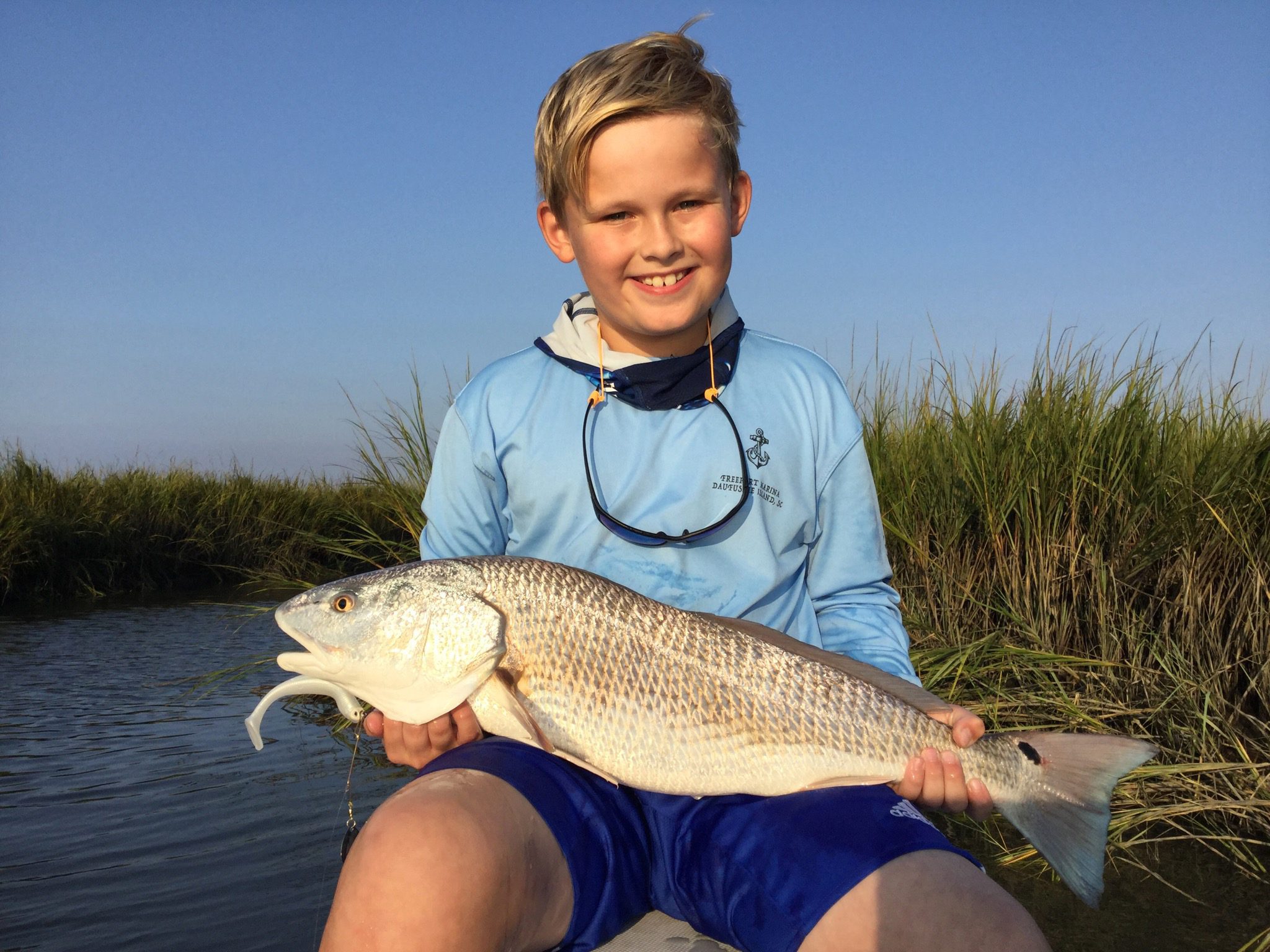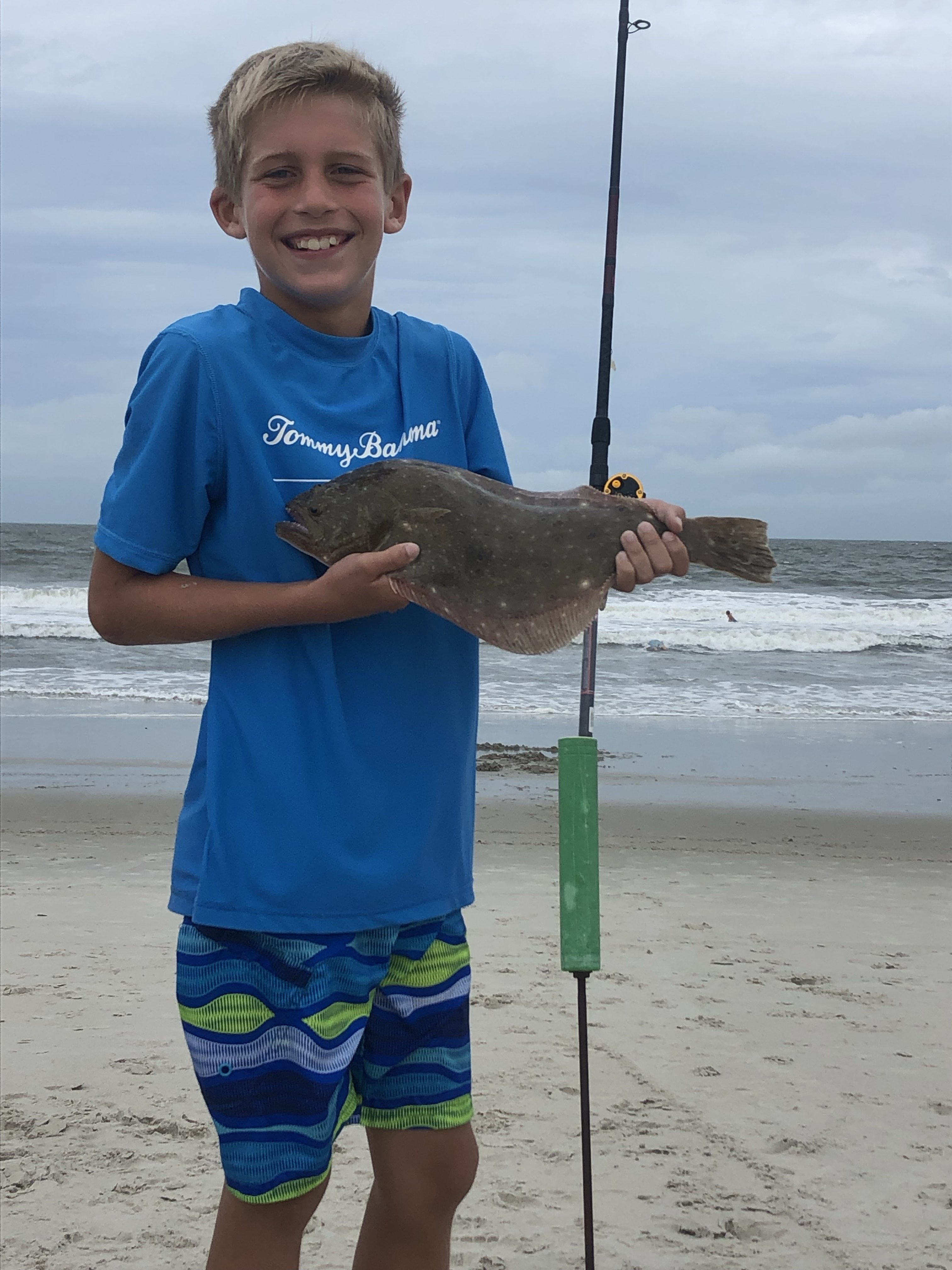Carolina Beach – October 10, 2019
Kevin, of Island Tackle and Hardware, reports that in the Cape Fear River and waterway, speckled trout fishing has remained steady. Those casting out live shrimp under a popping cork or hard baits like topwater lures and MirrOlure MR17s have produced good numbers of fish. Targeting marsh points and oyster beds has been most productive.
The redfish bite has started to pick up. Anglers fishing with live finger mullet have done best, and docks and oyster structure have been the top producers for the reds.
At the mouth of the Cape Fear River, anglers have found a couple of bull drum ready to eat. Fishing has been off and on, but those willing to cover good amounts of water with large cut baits have done well on these big reds.
Fishing from the surf and pier has kept anglers busy. Fresh shrimp and sand fleas have worked well for whiting, croaker, and pompano, while casting Gotcha plugs and Stingsilvers from the pier has produced good numbers of bluefish and a few spanish. Slot-sized red drum have also been landed in the suds. Cut mullet has been the best way to hook the reds.
In the 20-25 mile range, the kings have been feeding. Most fish have been on the smaller side, though. A few mahi have been holding in the same areas.
The wahoo have continued to be active further offshore in the bluewater.

Henry Kitchin with a 28″ red drum caught on a spinnerbait at Buzzard’s Bay.
Christian, of Seahawk Inshore Fishing Charters, reports that anglers looking for red drum have had success in the shallow creeks of the lower Cape Fear River. Tossing live finger mullet on Carolina rigs near oyster structure and marsh points has been the tactic of choice.
The black drum bite has been up and down. On some days anglers have landed good numbers, and on other days the fish can’t be found. Most of the black drum have bit fresh shrimp fished on the bottom, and targeting oyster beds and deeper holes has been the ticket to finding them.
A few speckled trout are starting to be caught in the area. The lure of choice has been a Trout Trick rigged on a 1/4 oz. jig head.
Off the beach, the citation red drum bite has been hit or miss. A few fish have been landed, but overall the big red drum action has been slow.
A few schools of false albacore have been feeding just off the beach. Casting jigs to busting fish has been the best way to hook up.

Mason Lutterloh (age 9) with a 17″ flounder that fell for a Gulp swimbait in the Carolina Beach surf.
Luke, of Spot On Charters, reports that speckled trout have started to feed actively in the Cape Fear River. Anglers tossing topwater plugs near marsh lines, as well as live shrimp under float rigs, have picked up limits of fish.
Those looking for red drum have had success targeting the docks in the waterway and the Cape Fear River. Tossing out a live finger mullet on a Carolina rig has been the best way to land the reds. Artificials (such as Down South Lures soft plastics and Gulp shrimp) on a 1/4 oz. jig head have also worked well. Most fish have been between 20-24”, but a few upper-slot fish have been in the mix.
Just off the beach, the spanish bite is still steady. Casting Shore Lures around baitfish pods has been the best way to land them. A few false albacore have also been in the mix.
Luke, of Coastline Charters, reports that red drum fishing has been on fire inshore, as well as off the beach. Inshore, topwater baits worked early in the morning and late in the day are catching fish. In addition, soft plastics like Z-Man products with a Blue Water Candy jig head are good go-to options. Live and cut baits fished on Carolina rigs will produce the most action, though. Oyster bars, deep holes, grass lines, and docks are where the reds are going to be hanging out.
Masonboro Inlet, especially the jetties, are full of big reds, with good numbers of citation-class fish in the mix. There are also good numbers of reds on the nearshore wrecks. Fishing live and cut baits at these locations will put fish in the boat.
The speckled trout action has turned the corner and anglers are enjoying the typical, strong fall bite. Topwater lures first thing in the morning and late in the day is the best way to start out. Live shrimp under a float rig will get the trout to bite, too, as will D.O.A. and Vudu shrimp. Deep holes, grass banks, and oyster bars are great places to look for the specks.
There are still decent numbers of black drum around. Soaking fresh shrimp on a Carolina rig near oyster bars and docks should generate a bite (or two or three). This action is going to improve as the cooler water temperatures move in.
Rod, of OnMyWay Charters, reports that larger spanish (in the 3-5 lb. range) have been feeding just off the beach. A mix of trolling Clarkspoons and live baits has worked well for the spanish. A few fish landed have even pushed the 7 lb. mark.
Kings have started feeding along the beaches. Most of the kings have been in the 15-25 lb. range, with a few bigger fish in the mix. The kings are also being landed in the 5-10 mile range, with live baits the best way to land them.
In the 25-35 mile range, the bottom fishing has picked up. Grouper, beeliners, and pink snapper have been willing to take an assortment of live and cut baits.
Out at the Gulf Stream, the wahoo bite remains solid. A few mahi and sailfish have been in the mix as well.
Jeff, of Kure Beach Pier, reports that the spanish bite has turned on and anglers tossing Gotcha plugs have found plenty of action.
Those fishing the bottom have landed whiting, spot, bluefish, and a few keeper flounder.





